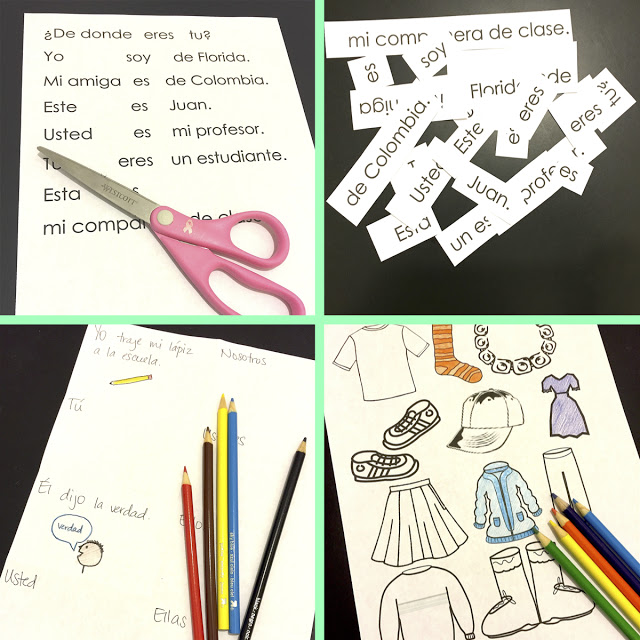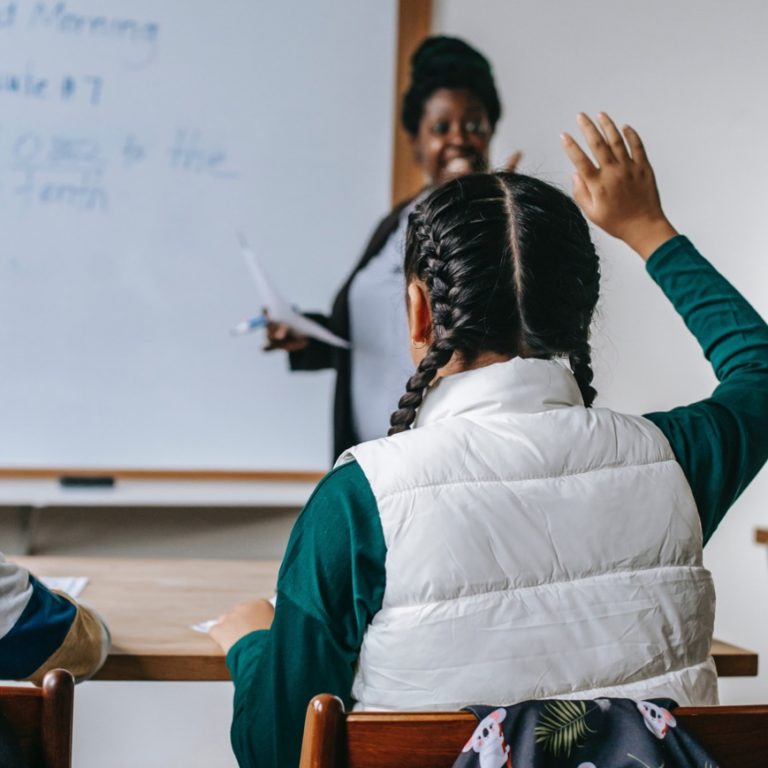
1. FLYSWATTER GAME (MATAMOSCAS)
BEFORE PLAYING
Write the vocabulary words you want students to review on the whiteboard like in the picture below. Here, there, and everywhere. (Pro tip: Have a TA? This is a great thing for them to do for you!)Teach a different subject? You could use the definition for science class, a math problem in math class, a synonym in ELA class, whatever you choose!
TO PLAY
1. Divide the class into two teams. (read about how I quickly put students into groups using index cards HERE.) Give them 30 seconds to come up with a team name and write the names on the board. If they cannot come up with a team name in that amount of time, make something up for them. “I Love Justin Bieber” is one of my personal favorites.
2. Instruct students to line up in two single-file lines facing the whiteboard. The first person in line should be 8-10 feet from the whiteboard. Hand the first person in each line a flyswatter. In a pinch, rolled up construction paper works, too. (If you have a TA, now is the time to ask them to stand/sit on the other side of the whiteboard from you so they can help you determine who hit the correct vocabulary word first.)
3. For Spanish class, tell students that you are going to say a vocabulary word in English. The first person to touch the Spanish version of that word with their flyswatter will earn one point for his/her team. If someone in line shouts out the answer, the other team will earn a point. Tell them no shoving, hitting, etc. They also can’t just go up and hit every single word until they get lucky and touch the correct one.
4. Call out vocabulary words in English one at a time. The first person to touch that word in Spanish will earn one point for his/her team! Increase engagement and understanding for everyone, not just the two hitting the board, by asking the whole class “¿Cómo se dice ____?” after each word and getting them all to shout the word in Spanish back to you.
5. The team with the most points at the end wins!
VARIATION: Instead of writing the vocabulary words, hang up pictures for them. Call out the word in Spanish and the first person to touch the correct picture earns a point!
2. MEMORY
Remember playing Memory as a kid? It was one of my favorites! Guess what- it is just as much fun to play in class!
TO PLAY
1. Put students in pairs. Each group needs scissors, a piece of paper, and two pens (read about how I streamline the materials process with material boxes HERE.) Use one of my transition tip questions to quickly decide who will cut the paper (STUDENT 1). The other person in the group (STUDENT 2) can get two pens out and ready to use.
2. Have STUDENT 1 grab scissors and an 8.5 x 11 piece of paper. The paper can be scratch paper, white computer paper, construction paper, whatever. You are only writing on one side. That person needs to cut the paper into 24 squares. I hold up a piece of paper and walk them through how to do that by folding it to show where they cut.
“Cut the piece of paper in half length-wise. Next, cut those two pieces of paper in half length-wise again. Then, cut those four pieces of paper in half the other way (width-wise? Is that a word?). Finally, cut those pieces of paper into thirds width-wise. You should have 24.”
Put up a list of what you want students to study/match up. 12 is an ideal number and matches up with the 24 squares STUDENT 1 cut. In Spanish class, this might be a list of vocabulary words in Spanish and English in a Spanish 1 class and vocabulary words in Spanish and their definitions in a Spanish 3 class. In math class, it might be the names of theorems and examples. Chemistry class? it might be the names of elements and their symbols.
Divide the pieces of paper in half. Have STUDENT 1 write the column on the left and STUDENT 2 write the column on the right (i.e. one student writes all the words in Spanish and one student writes all the words in English).
Once they have that done, have them make sure they can’t see through the cards. They might have to scribble on the back if they used white paper and a dark-colored marker.
As soon as the cards are ready to go, have STUDENT 2 flip them over so they are face-down and mix them up. STUDENT 2 then needs to arrange them in a 6 x 4 grid (see below).
The first couple of times we play this game, I draw a 6 x 4 table on the board so they can see what it should look like.
3. STUDENT 1 goes first the first round. STUDENT 1 turns over any two cards. They HAVE to turn the cards over where they are on the desk. No fair picking them up, looking at them, and putting them back down, lifting just a corner so only they can see it, etc. Both students need to be able to see them. If the two cards are a match, STUDENT 1 puts the cards in front of him/her and goes again. If the two cards are not a match, it is STUDENT 2’s turn. Students keep taking turns flipping over cards until all matches have been made.
4. As soon as a group is done, have the winner come stand at the front of the room. The non-winner needs to mix up the cards and get them ready to use again. Once a second group is done, have the two winners play each other and the two non-winners play each other (one non-winner will need to move).
5. Continue shuffling kids around, winners playing winners and non-winners playing non-winners, until they’ve had at least three chances to play. Some students will get more rounds in than that, but I always try to get a minimum of three for each student.
3. RED/YELLOW/GREEN (ROJO/AMARILLO/VERDE)
This “game” is really a fantastic formative assessment in disguise. I love it because students get IMMEDIATE feedback on what they know and what they need to work on.
BEFORE PLAYING
Prep strips of paper with what vocabulary you want to review. In Spanish class, I type up a vocabulary list with words in Spanish and English side by side and then cut that list into strips, one vocabulary word in Spanish and English per strip of paper. I italicize words in English to make it easier for students to distinguish between the two languages when I type the list up. You will need a set of cut-up slips of paper for each group. You will also need three small colored pieces of paper for each group, one red, one yellow, and one green. Cutting a piece of paper into quarters would make the perfect size.
TO PLAY
1. Put students into pairs. Give each group one small red piece of paper, one small green piece of paper, and one small yellow piece of paper, as well as a set of vocabulary words.
2. Have students place the colored pieces of paper like in the picture above (red then yellow then green). I like to hang up full-size pieces of red, yellow, and green paper on the whiteboard to show students how to arrange them and for the demonstration in #3. Use one of my transition tip questions to quickly decide who goes first (STUDENT 1). The other person in the group (STUDENT 2) needs to pick up all the vocabulary words and hold them in his/her hand so they cannot be seen by STUDENT 1.
3. Explain the game to students. Doing a quick demonstration with a student works best. (Hint: I always pick a student that I am confident knows the vocabulary so as not to embarrass a student who might not know a word in front of the entire class.) I give the student a word in English and he tells me the word in Spanish. I ask the class if it is correct. They all say yes and I put the vocabulary word FACE UP on the green piece of paper on the board with tape. GREEN = GOOD (correct).
I give the student another word and whisper to him to start to say the wrong word and then correct himself. I ask the class if he got it right on the second guess. They say yes and I show them how I put that vocabulary word FACE UP on the yellow piece of paper. Again, pointing to the correct color and really emphasizing how the slip of paper with the vocabulary word gets put face up on yellow.
Finally, I give the student a word and whisper to him to get it wrong. Then I ask the class if that is correct. They all say no and I show them how I put that word FACE UP on the red piece of paper. RED = WRONG. The face-up piece is really important.
By putting the vocabulary words face up, students get immediate, visual feedback on what words they know and what words they need to study a little more. Emphasize during your explanation the importance of being kind during the activity. Tell students there is no need to say a single word after their partner makes a guess. Them putting the piece of paper on the proper color will tell their partner if they were correct or incorrect. Comments like “Ha! You’re wrong!” or “You’re stupid!” will not be tolerated.
4. Have STUDENT 2 quiz STUDENT 1 with the slips of paper. In Spanish class, I have STUDENT 2 say the word in Spanish the first time around and elicit the word in English from STUDENT 1. Once STUDENT 2 goes through all of them, have him pick up any on the red paper and quiz STUDENT 1 on those words again.
5. After STUDENT 1 is done, he picks up the pieces of paper and quizzes STUDENT 2.
6. Once both students have gone through Spanish –> English, STUDENT 2 becomes the person to ask again, but this time he says the word in English and elicits the vocabulary word in Spanish from STUDENT 1. Repeat steps 4 and 5.
Idea: Have students jot down any words that ended up on red or yellow on a piece of paper and collect those as an exit slip at the end of the period to get an idea of what vocabulary words students need the most help with.
4. GO FISH (PESCA)
Put an educational twist on a childhood favorite with Pesca! This example is for Spanish class but you can use vocabulary from any subject you want!
all the cards face down.
face down in the middle.
his hand. If his card is a vocabulary word in Spanish, the
match is the English translation and should be asked for in English.
my hand, I ask Liam for towel since
that is the match.
puts the matching pair on the desk in front of him/her and goes again. If that
person does not have that card, he/she says “¡Pesca!” (Go Fish) and the dealer draws a card from
the pile in the middle and puts it in his/her hand. It is then the person on
the left’s turn.
the person with the most matches when time is called.
If you are a Spanish teacher and want to try Pesca for free, here is a freebie for greetings, farewell, and introduction vocabulary! See all 60+ Pesca games for verb tenses and vocabulary topics in my store HERE.
kj



















2 Comments
My Pesca decks are usually verb forms, though I have done sets of vocab and forms of adjectives. (Tienes formas de “Nadar”? Tienes formas de “contento”? Tienes “animales verdes”?) When they get a set of four, they have to say the Spanish and translate each one. With verbs, they have to say what forms are missing.
Thanks for sharing such a great idea, Erin!